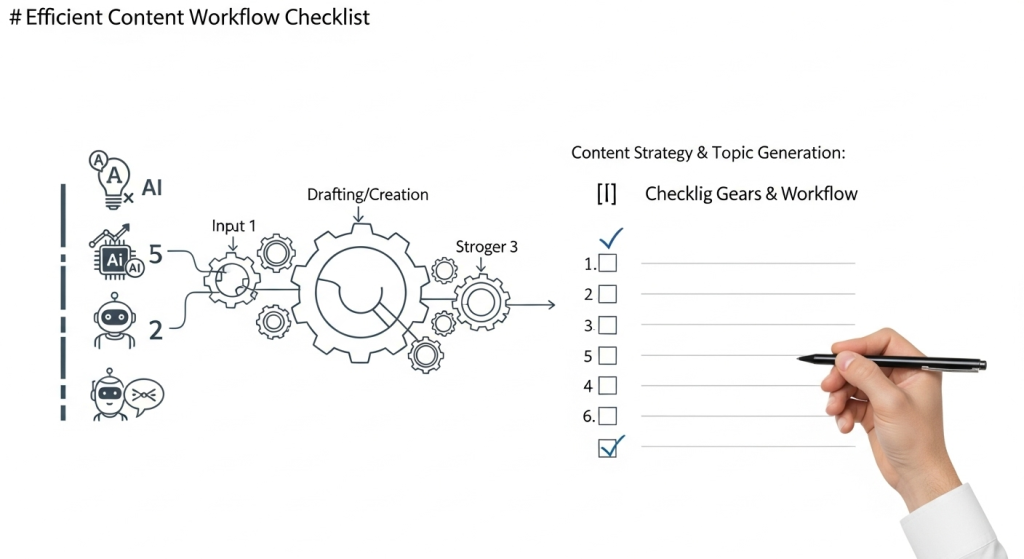In today’s fast-paced digital world, creating engaging and high-quality content is a constant challenge. Businesses and marketers, therefore, constantly seek new ways to stand out. This is precisely where an AI content strategy becomes not just helpful, but essential. It helps you work smarter.
Artificial Intelligence (AI) now offers powerful tools that can transform how you plan, create, and distribute your content. For example, AI can analyze vast amounts of data in seconds. Furthermore, it can help you understand your audience better and even draft compelling copy. This comprehensive guide will show you exactly how to build a robust content strategy using AI, ensuring your efforts lead to real results.
Table of Contents
- Why an AI Content Strategy is Essential Today
- Understanding the Pillars of an Effective AI Content Strategy
- Step-by-Step: Building Your AI Content Strategy
- Case Study: “GrowthCo” Scales Content with AI
- Practical Toolkit & Checklist for Your AI Content Strategy
- The Human Element in an AI Content Strategy
- Key Facts About AI Content Strategy
- Frequently Asked Questions (FAQ) about AI Content Strategy
- Conclusion
Why an AI Content Strategy is Essential Today
The digital landscape is more competitive than ever before. Consumers are bombarded with information. Therefore, standing out requires more than just good ideas. It demands efficiency, precision, and personalization. AI offers all these benefits, changing the game for content creators.
The Evolving Content Landscape
Today’s audience expects high-quality content that truly speaks to them. They want answers, entertainment, and information, often immediately. Consequently, the sheer volume of content needed to meet these demands can overwhelm even large teams. This is a significant challenge for businesses of all sizes.
Furthermore, search engines like Google constantly update their algorithms. They prioritize valuable, well-researched, and unique content. Marketers, therefore, need to produce content that performs well in search results while still resonating with human readers. This balance is tricky without the right tools.
The Power of AI in Content Creation
AI brings incredible advantages to your content efforts. For example, it significantly boosts efficiency. AI tools can handle repetitive tasks, freeing up your team for more strategic work. This means less time spent on basic research and more time on creative refinement.
In addition, AI allows for deep personalization. It can analyze user data to suggest topics or even tailor content variations for different audience segments. As a result, your content feels more relevant to each individual. This naturally leads to higher engagement rates.
Moreover, AI provides powerful data insights. It can identify trends, predict performance, and highlight content gaps you might miss. Therefore, you can make data-driven decisions that improve your strategy. This ensures your AI content strategy is always moving in the right direction.
Understanding the Pillars of an Effective AI Content Strategy
A successful AI content strategy isn’t just about using AI tools. It’s about integrating AI into every key stage of your content workflow. This approach builds a strong foundation for long-term success. Let’s look at the main pillars.
Goal Setting and Audience Definition
Every great content strategy starts with clear goals and a deep understanding of your audience. AI helps you refine these areas. For instance, AI can analyze market trends and audience demographics more efficiently. This helps you identify what your potential customers truly care about.
Furthermore, AI tools can help create detailed buyer personas based on real data. This allows you to tailor your content specifically to their needs and preferences. Consequently, your content becomes far more impactful from the start.
Keyword Research and Topic Generation with AI
Finding the right keywords is vital for search engine visibility. AI excels at this task. It can process vast amounts of search data to uncover high-ranking keywords, including often-missed long-tail variations. Additionally, AI tools can analyze competitor content. This helps you discover content gaps and untapped topic areas.
Moreover, AI can generate fresh content ideas based on current trends and popular searches. This means you always have a pipeline of relevant topics. It ensures your AI content strategy remains relevant and engaging.
Content Creation and Optimization
AI significantly speeds up the content creation process. It can generate outlines, draft sections of text, and even suggest improvements for clarity and tone. However, human review is always necessary to ensure accuracy and maintain your brand voice. Think of AI as your powerful co-pilot.
For optimization, AI can analyze your content for SEO best practices. It checks readability, keyword density, and even suggests internal linking opportunities. This helps your content rank higher. As a result, more people discover your valuable information.
Content Distribution and Promotion
Getting your content seen is just as important as creating it. AI tools can automate aspects of content distribution. For instance, they can schedule social media posts at optimal times for maximum reach. They also help repurpose content into different formats, like summaries or short videos.
Furthermore, AI can analyze which channels perform best for specific content types. This allows for smarter promotion strategies. Consequently, your content reaches the right audience on the right platform, increasing its overall impact.
Performance Analysis and Iteration
Measuring performance is crucial for continuous improvement. AI-powered analytics tools provide deep insights into how your content is performing. They track metrics like engagement, conversions, and traffic. This helps you understand what works and what doesn’t.
Moreover, AI can identify patterns and even predict future trends. This allows you to iterate and refine your strategy based on real-time data. Therefore, your AI content strategy becomes a living, evolving plan that consistently delivers results.
Step-by-Step: Building Your AI Content Strategy
Building an AI content strategy might seem complex, but by breaking it down into manageable steps, it becomes very achievable. Follow these stages to integrate AI effectively into your content workflow.
Step 1: Define Your Goals and Audience
Before writing anything, clarify what you want to achieve. Do you aim for more website traffic, increased sales, or better brand awareness? Furthermore, who are you trying to reach? Use AI tools to analyze your existing audience data and market trends. This helps create precise buyer personas. Defining your target audience accurately is the first critical step.
For example, AI can identify common questions your audience asks. It can also spot their preferred content formats. This data forms the bedrock of your AI content strategy.
Step 2: Leverage AI for Deep Research
Traditional research can take hours. AI, however, speeds this up dramatically. Use AI-powered tools to perform comprehensive keyword research. These tools can identify high-volume, low-competition keywords quickly. Additionally, they help discover trending topics and content gaps in your niche.
Furthermore, AI can analyze competitor content strategies. It reveals what they rank for and where their content might be weak. This gives you a clear advantage. Therefore, you can create better content that fills unmet needs.
Step 3: Generate and Outline Content Ideas
Once you have your research, AI can help with idea generation. Provide AI with your keywords and target audience. It can then brainstorm countless content titles and subheadings. This is especially useful when facing writer’s block.
Moreover, AI can generate detailed outlines for your articles, blog posts, or video scripts. This ensures a logical flow and covers all necessary points. It also helps maintain consistency across your content team.
Step 4: Create AI-Assisted Content
Now, it’s time to create the content itself. AI writing assistants can generate initial drafts for various content types. This includes blog posts, social media captions, email newsletters, and even product descriptions. They can quickly expand on your outlines.
However, remember that AI is a tool, not a replacement for human creativity. Always review and edit the AI-generated text. Refine it to match your unique brand voice and ensure factual accuracy. This ensures high-quality output.

Step 5: Optimize and Refine with AI Tools
After drafting, use AI tools for optimization. These tools can check your content for SEO best practices. They suggest improvements for readability, grammar, and sentence structure. This helps your content perform better in search results.
Furthermore, AI can detect plagiarism, ensuring your content is original. It also helps with internal and external linking strategies. Therefore, your content becomes more authoritative and user-friendly.
Step 6: Automate Distribution and Promotion
AI can streamline the distribution process. Use AI-powered social media management tools to schedule posts across platforms. These tools often analyze optimal posting times for your audience. They also help repurpose content into bite-sized pieces for different channels.
Additionally, AI can personalize email marketing campaigns. It suggests relevant content to subscribers based on their past interactions. This improves open rates and engagement. AI’s role in marketing is growing rapidly, making these tasks much easier.
Step 7: Analyze and Adapt
Finally, continuously monitor your content’s performance. AI analytics tools provide detailed reports on traffic, engagement, conversions, and more. They identify which content pieces are successful and why. This feedback loop is essential.
Based on these insights, adapt your AI content strategy. Adjust your topics, formats, or distribution channels as needed. This iterative process ensures your content remains effective and relevant over time.
Case Study: “GrowthCo” Scales Content with AI
GrowthCo, a mid-sized B2B SaaS company, struggled with content production. Their small marketing team could only publish 2-3 blog posts per month. This limited their organic traffic growth significantly. They needed a way to scale without hiring a massive team.
The Challenge: Limited Resources, High Aspirations
GrowthCo aimed to become a thought leader in their industry. However, their content output was too low to compete with larger companies. Research, writing, and optimization took too long. They simply lacked the resources for consistent, high-volume content.
The AI Solution: A Strategic Overhaul
GrowthCo decided to implement a full AI content strategy. They adopted a suite of AI tools. First, they used AI for advanced keyword research and competitive analysis. This helped them identify hundreds of relevant topics their audience searched for.
Next, they integrated an AI writing assistant into their workflow. Their team used it to generate outlines and first drafts for blog posts and whitepapers. Importantly, human writers then reviewed, fact-checked, and added their unique insights and brand voice.
Finally, they used AI for SEO optimization and content repurposing. The AI helped them create variations for social media, email snippets, and even short video scripts from longer articles. This multiplied their content’s reach.
The Results: Scaled Content, Boosted Growth
- Content Volume: Increased from 2-3 blog posts per month to 10-12, a 300-400% increase.
- Organic Traffic: Saw a 70% increase in organic website traffic within six months.
- Time Savings: Reduced the average time to produce a blog post by 40%.
- Engagement: Noted a 25% improvement in time-on-page and lower bounce rates due to more relevant content.
Key Takeaways
GrowthCo’s success showed that AI isn’t about replacing humans. Instead, it’s about empowering them. The team focused on higher-value tasks like strategy and deep editing. AI handled the heavy lifting of research and drafting. This hybrid approach proved highly effective for scaling content production and achieving significant growth.
Practical Toolkit & Checklist for Your AI Content Strategy
To effectively build an AI content strategy, you need the right tools and a structured approach. This toolkit provides a starting point for your journey.
Essential AI Tools for Content
- Research & SEO: Tools like SEMrush, Ahrefs (with their AI features), Surfer SEO, and Frase.io help with keyword research, competitor analysis, and content optimization. They analyze search results to guide your content.
- Writing Assistants: Platforms like Jasper, Copy.ai, and Writer help generate outlines, first drafts, and variations of content. They are excellent for overcoming writer’s block and speeding up production.
- Grammar & Readability: Grammarly (premium version) uses AI to check for grammar, spelling, punctuation, and even tone. It also offers suggestions for improving clarity and conciseness.
- Image & Video Generation: Tools such as Midjourney, DALL-E, or Stable Diffusion can create unique images from text prompts. For video, platforms like Synthesia can generate AI presenters for explainer videos.
- Analytics & Insights: Google Analytics (especially with its AI-powered insights), Looker Studio, and specialized AI dashboards can track performance, identify trends, and provide actionable recommendations.
Automating Your Content Workflow
Integrating an AI-powered content suite can dramatically streamline your entire content process. This integration moves beyond using separate tools for each task. Instead, it creates a unified, efficient workflow.
Consider platforms like BlogZenn.com. Such a suite offers a comprehensive solution for content automation. First, it automates research, allowing you to quickly gather data, keywords, and insights without manual effort. This saves hours of work.
Second, it significantly speeds up drafting. AI can generate full article drafts, detailed outlines, and multiple variations of content much faster than a human. This helps you maintain a consistent publishing schedule.
Furthermore, these suites often include visual creation capabilities. They can generate relevant images or suggest visuals to accompany your text. This ensures your content is not only well-written but also visually appealing.
As a result, using an all-in-one platform like BlogZenn.com saves an enormous amount of time. It helps businesses scale content production significantly. You can produce more high-quality content without needing a larger team. This allows your human talent to focus on strategic thinking and refinement, rather than repetitive tasks.
Your AI Content Strategy Checklist
- Define Clear Goals: What do you want your content to achieve? (e.g., traffic, leads, sales)
- Identify Target Audience: Who are you trying to reach? Use AI for persona development.
- Conduct AI-Powered Keyword Research: Discover high-potential keywords and topics.
- Generate Content Ideas & Outlines: Use AI to brainstorm and structure your content.
- Draft Content with AI Assistance: Create first versions of articles, posts, etc.
- Human Edit & Fact-Check: Ensure accuracy, brand voice, and quality. This step is non-negotiable.
- Optimize for SEO with AI Tools: Check readability, keywords, and internal links.
- Plan Distribution & Promotion: Use AI for scheduling and personalized outreach.
- Monitor Performance: Track key metrics with AI analytics.
- Iterate & Improve: Adapt your strategy based on data insights.

The Human Element in an AI Content Strategy
While AI offers incredible capabilities, it’s crucial to remember that it’s a tool. The human touch remains irreplaceable in creating truly impactful content. Your AI content strategy thrives when humans guide and refine AI’s output.
The Editor’s Indispensable Role
Human editors bring several critical elements that AI simply cannot. First, they ensure factual accuracy. AI can sometimes “hallucinate” or provide incorrect information. A human editor, therefore, must verify all facts.
Second, editors maintain brand voice and tone. AI can mimic styles, but it often lacks the nuanced understanding of a brand’s unique personality. An editor ensures every piece of content truly sounds like your brand.
Moreover, humans add creativity, empathy, and emotional depth. They can craft compelling narratives and connect with readers on a deeper level. This emotional resonance is something AI struggles to replicate. The future of creative work with AI highlights this collaboration.
Ethical AI Use and Bias Mitigation
AI models learn from vast amounts of data. If this data contains biases, the AI output will reflect those biases. This means AI-generated content can sometimes be unfair, inaccurate, or even harmful.
Consequently, human oversight is essential to review AI output for any signs of bias. Ensure your content is inclusive, respectful, and accurate. Regularly audit your AI tools and the data they use. This ethical approach is a cornerstone of a responsible AI content strategy.
Key Facts About AI Content Strategy
| Aspect | Description |
|---|---|
| Efficiency Boost | AI automates repetitive tasks, dramatically speeding up research, drafting, and optimization. |
| Scalability | Allows businesses to produce significantly more content without proportionally increasing staff. |
| Personalization | AI can analyze data to tailor content for specific audience segments, increasing relevance. |
| Data-Driven Insights | Provides deep analytics to track performance, identify trends, and inform strategic decisions. |
| Human Oversight | Crucial for fact-checking, maintaining brand voice, adding creativity, and ensuring ethical standards. |
| SEO Enhancement | AI tools optimize content for search engines, improving rankings and visibility. |
| Content Quality | When used correctly, AI assists in producing higher-quality, more consistent content. |
Frequently Asked Questions (FAQ) about AI Content Strategy
Q1: Can AI fully replace human writers?
No, AI cannot fully replace human writers. AI is a powerful tool for generating drafts, outlines, and automating repetitive tasks. However, humans are essential for critical thinking, fact-checking, adding unique insights, maintaining brand voice, and ensuring ethical considerations. A hybrid approach, therefore, yields the best results.
Q2: Is AI-generated content penalized by search engines?
Google states that using AI to generate content is not against its guidelines, as long as the content is high-quality, helpful, and original. The key is to ensure the AI-generated text is edited, fact-checked, and provides real value to users. Poorly written, unedited, or spammy AI content will likely be penalized. Google’s guidance on AI content emphasizes helpfulness.
Q3: How do I ensure brand voice with AI?
You can train some advanced AI tools on your existing content to help them learn your brand voice. However, human editors remain crucial. They must review and refine AI-generated content to ensure it perfectly aligns with your brand’s unique tone, style, and messaging. Consistency is key.
Q4: What’s the biggest mistake in using AI for content?
The biggest mistake is treating AI as a “set it and forget it” solution. Simply publishing AI-generated content without human review or optimization will likely lead to low-quality, inaccurate, or unengaging results. Always combine AI’s speed with human intelligence and creativity.
Q5: How much does AI content software cost?
Costs vary widely depending on the features and usage. Many AI writing tools offer free trials or basic free tiers. Paid subscriptions can range from $20/month for individual writers to hundreds or thousands of dollars for enterprise-level suites with advanced features and high usage limits. Research specific tools like BlogZenn.com to find one that fits your budget and needs.
Conclusion
Building a strong AI content strategy is no longer an option; it’s a necessity for businesses aiming to thrive in the digital age. AI empowers your team to work with unprecedented efficiency, precision, and scalability. It helps you understand your audience better and produce a higher volume of quality content.
Remember, the most successful strategies combine the power of AI with the indispensable creativity, empathy, and critical thinking of humans. Use AI to automate the mundane and accelerate the difficult. Then, let your human talent elevate the content to truly resonate with your audience.
Start integrating AI into your content workflow today. Explore tools, experiment with different approaches, and embrace the future of content creation. Your audience and your bottom line will thank you.

